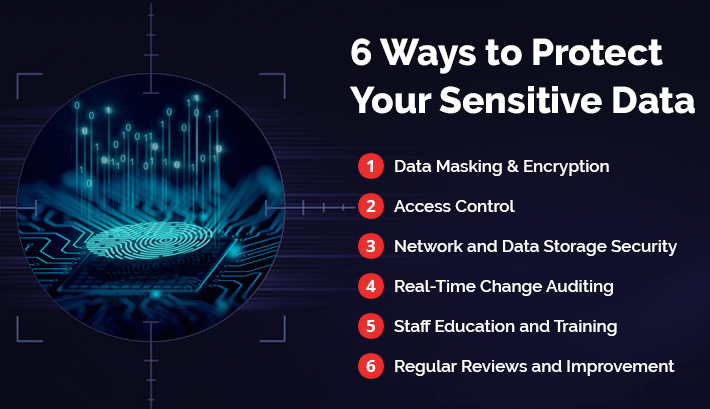Last Updated on December 24, 2024 by Satyendra

Sensitive data can be found in various forms, including traditional formats like paper files, local digital storage, and remote cloud storage. However, without a robust security plan in place, this sensitive information is vulnerable to being breached, resulting in identity theft and erosion of trust among staff, clients, and the public. The alarming frequency of major data breaches serves as a stark reminder of the significant risk involved in exposing sensitive data to unauthorized access. As such, it is essential to identify what constitutes sensitive data and implement effective measures to protect it. The following article will delve into the specific data types and provide essential strategies to incorporate into your organization’s security plan to safeguard sensitive data.
What is Classified as Sensitive Data?
Sensitive data is the most critical type of data that organizations need to identify and protect. This category of data is particularly important because it has the potential to cause harm to individuals and businesses if it falls into the wrong hands. Sensitive data can be categorized into several types, including:
- Personal Information: This type of data includes personal details that can identify or relate to a person or household, such as names, addresses, and other identifying information.
- Private Information: This category includes encrypted or unencrypted data that poses a higher risk of exposure for individuals, such as financial information, medical records, and other sensitive data.
- Identifying Biometric Data: This type of data includes biometric data that can be used to identify a person, such as fingerprints, facial recognition data, and other biometric information.
In addition to these categories, there are more specific types of sensitive data that are subject to regulations and require higher levels of security:
- Personally Identifiable Information (PII): This category includes data that can be used to identify a person, such as names, Social Security numbers, and other identifying information.
- Sensitive Personal Information: This category includes sensitive personal data with higher security standards due to greater risk and stringent regulations. It includes data related to racial or ethnic origin, political beliefs, and religious affiliations.
- Protected Health Information: This type of data includes medical information that is disclosed when providing healthcare services and can identify an individual.
- Material Nonpublic Personal Information: This category includes publicly traded company information and holdings that has not been made public or available to investors.
How To Protect Your Sensitive Data
Due to the high risk of misuse, storing and processing this sensitive data requires utmost care. Prior to collection, it is crucial to assess the necessity of processing sensitive data, as it may not always be necessary for the intended purpose. To ensure the security of your data, it’s essential to identify the regulations that apply to your organization. This includes GDPR, HIPAA and PCI-DSS, to name a few. Understanding these regulations will help you develop a comprehensive data security plan. Below are some of the key ways that you can protect your sensitive data:

Data Masking & Encryption
To protect sensitive data, you can use data masking to obscure the data, making it unreadable to unauthorized users. You can also use encryption to protect data in transit and at rest, and ensure that only authorized users can access the data. Ensure full disk encryption (FDE) is enabled on all devices that store or transmit confidential data, such as Windows (BitLocker), macOS (FileVault), and most mobile devices (iOS and Android). This will prevent unauthorized access to sensitive data in case the device is lost or stolen.
Access Control
Implement access control measures such as role-based access control (RBAC) and attribute-based access control(ABAC) to restrict access to sensitive data.
Network and Data Storage Security
To protect your network and data storage, implement a firewall, VPN, and ensure that your software and systems are up to date. Regularly back up your data and store it in three separate locations, and ensure that your backup process is secure.
Real-Time Change Auditing
Use a real-time change auditing solution that will detect and respond to suspicious events concerning your sensitive data. When suspicious activity is detected, your security team should be notified immediately via email, or another form of communication.
Staff Education and Training
Provide your staff with the necessary training and resources to handle sensitive data securely. Educate them on how to detect and report phishing attacks, and provide them with secure communication channels. Ensure that they understand the importance of data security and their role in maintaining it. Encourage a culture of transparency within your organization, where employees feel comfortable reporting data breaches and mistakes.
Regular Reviews and Improvement
Regularly review your data security policies and procedures to ensure they are effective and up to date. Stay up to date with new risks and vulnerabilities, and update your security measures accordingly. Ensure that your data security plan is regularly reviewed and audited to ensure compliance with regulatory requirements.
Additional Measures
To ensure the secure handling and storage of physical data, it is essential to limit physical media, such as external hard drives or flash drives, to office use only and encrypt data before transferring it to prevent unauthorized access. Additionally, sensitive data that is no longer needed should be deleted and securely erased to prevent recovery. This includes using a file-shredder utility to erase devices and encrypting backups to prevent unauthorized access. To further ensure data protection, it is recommended to store backups in a secure location, such as a cryptocontainer, and keep multiple copies of sensitive data in isolated locations, including on your computer, external drive, and cloud storage. Finally, passwords should be stored securely using a purpose-built application and data backup processes should be automated to prevent loss of sensitive data, ensuring that sensitive data is properly protected and easily accessible when needed.
Where Should Sensitive Data be Stored?
Sensitive data is typically stored in a centralized, isolated, and encrypted repository, such as a secure database or a cloud-based storage solution with robust encryption and access controls. Such locations should be physically located in a secure environment, such as a server room or a data center, and have access controls in place, such as firewalls, intrusion detection systems, and biometric authentication. As above, data backup and disaster recovery procedures should be implemented to ensure that sensitive data can be easily recovered in the event of a disaster or system failure.
How Lepide Helps
Lepide Data Security Platform built-in data classification solution provides a set of features that simplify data discovery, classification, and access control, which in turn facilitates the secure storage of sensitive data.
The solution enables you to quickly locate and classify sensitive data across unstructured data stores, aligning with compliance regulations. It can also classify sensitive data at the point of creation, which not only ensures instant value and visibility, but also helps security teams determine the most appropriate location for the data to be stored.
The solution can handle a wide range of file types, including documents, spreadsheets, and more. It can also locate data across a multitude of platforms, including both on-premise and cloud-based environments. It prioritizes data based on its risk level, allowing organizations to focus their data protection efforts on the most critical information.
If you’d like to see how the Lepide Data Security Platform can help you securely store your sensitive data, schedule a demo with one of our engineers.


 Group Policy Examples and Settings for Effective Administration
Group Policy Examples and Settings for Effective Administration 15 Most Common Types of Cyber Attack and How to Prevent Them
15 Most Common Types of Cyber Attack and How to Prevent Them Why AD Account Keeps Getting Locked Out Frequently and How to Resolve It
Why AD Account Keeps Getting Locked Out Frequently and How to Resolve It
